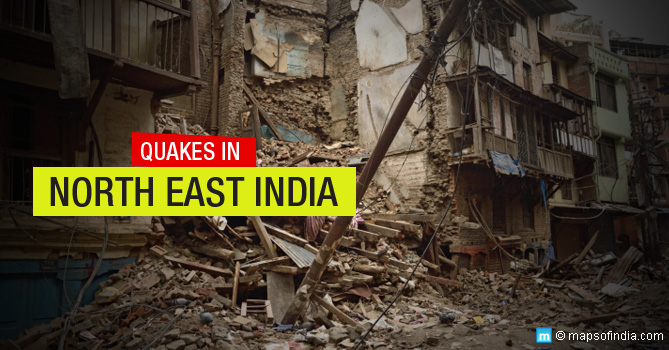In India, there are 5 earthquake prone zones – regions that are extremely susceptible to seismic activity. The northern and north-eastern regions, being mountainous Himalayan regions are more prone to being affected by frequent earthquakes. The north-eastern part of the country is not only located at the centre of one of the most active earthquake prone regions of the country, but is also exposed to very high damage given the nature of the terrain. Relief operations in the area become slow due to the great landslides that are triggered by earthquakes. Much of this region is also covered by thick forests adding on to the woes of rescue units. The recent Manipur earthquake of January 2016 has brought the region’s vulnerability into spotlight. Let us take a look at some of the worst earthquakes to have affected northeastern India.
1897 Assam Earthquake
Date: 12 June, 1897
Not only was the Assam Earthquake of 1897 one of the earliest recorded in the region, it was also one of the most devastating. The earthquake with a magnitude of 8.3 Mw measured 7.1 on the Richter scale. Assam and the north east were not much developed at the time and since the quake destroyed all means of communication, very little was reported. What is known, though, is that the impact was felt far through the region. Most of Assam and Cachar reeled under the damages and the cities of Guwahati, Shillong, Golpara, and Dhubri lost many lives and dwellings. Tura, Nagaon, Barpeta, and Nalbari also recorded much damage. About 1542 people were officially recorded dead in the earthquake at the time, though it is likely that many more lives were lost and faulty communication failure prevented proper recordkeeping. Injuries and damages to property and livestock were immense.
1934 Nepal–Bihar earthquake
Date: 15 January, 1934
The next major earthquake to affect northeast India was the great Nepal-Bihar earthquake of 1934. While the majority of the impact and the damages caused by this earthquake of magnitude 8.0 Mw was absorbed by the hilly nation of Nepal and by Bihar in India, the earthquake was felt from Punjab through parts of central India and Bengal and also affected many parts of Assam, and Sikkim. Though the exact number of causalities in north eastern India is hard to come by, the earthquake as a whole killed over 10,000 people.
1950 Assam earthquake
Date: 15 August, 1950
Even as the rest of the nation was celebrating the 3rd anniversary of Indian independence from British rule, a devastating earthquake of 8.6 Mw magnitude (8.7 on the Richter scale) ripped through the heart of Assam and its impact was felt across the north-eastern states of India and in Tibet. Although the epicenter of the earthquake was pointed in Rima (Tibet), the earthquake caused just as much destruction in Assam as well. It is estimated that in both Tibet and in India, the earthquake killed about 3000 people, destroying property and livestock as well. One of the more important effects of the earthquake was the landslide it caused in Assam near Dulungmukh blocking the Subansiri, an important tributary of the Brahmaputra. Unaware of this blockage, the villagers downstream ventured out into the fast drying riverbed and paid no heed to warnings issued by the government. Three days later as the blockade collapsed, the rush of water downstream flooded and drowned most villages. Over 800 people died or went missing in these floods.
2011 Sikkim earthquake
Date: 18 September, 2011
In September 2011, an earthquake of magnitude 6.9 Mw (6.8 on the Richter scale) rocked Sikkim and most of north east India. The impact of this earthquake was felt across Nepal, Bhutan, Bangladesh, and parts of Tibet. The epicenter was plotted at a distance of about 68 kilometres from the capital of Sikkim, Gangtok. Its occurrence at a highly populated area maximized damages and made rescue efforts very tough. About 111 people were reported dead, some 60 of them from Sikkim. About INR 1000 billion worth property was reported damaged as well causing yet another earthquake trauma to the people of north eastern India.
April- May 2015 Nepal earthquake
Date: 25 April, 2015
12 May, 2015
In April and in May 2015, two major earthquakes rocked Nepal and many parts of northern, north-eastern India. While the bulk of the devastation and damages were faced by Nepal, the impact of these earthquakes was faced by Sikkim and most of the north eastern states in varying degrees. These were among the worst earthquakes to have ravaged Nepal in recent times.
June 2015 Dibrugarh earthquake
Date: 28 June, 2015
On 28 June, 2015, an earthquake measuring 5.5 Mw struck Dibrugarh, in northern Assam. The tremors were felt across the state and in many parts of Bengal, Nepal, Bhutan, and Bangladesh. The quake was epicentered in Basugaon in Assam and all the north east states felt its impact. While no casualties were reported, there was some damage to property in the Dibrugarh district.
2016 Manipur earthquake
Date: 3 January, 2016
On the morning of 3 January 2016, an earthquake of magnitude 6.8 Mw struck north east India. The earthquake was epicentered in Manipur and caused widespread damage in the state. As yet, about 11 people have been reported dead and about 200 injured in the tremors and due to damage caused by the earthquake. Tremors were felt through Manipur, Arunachal Pradesh, Assam, Nagaland, Meghalaya, Mizoram and Tripura and reports of damages poured in from as far as West Bengal’s Murshidabad district.
This may not be the end of north eastern India’s woes, though. Disaster management consultants with the Ministry of Home Affairs are now predicting that northern and north eastern India may soon be hit by one or a series of earthquakes of magnitude of about 8.0 Mw in the near future. India’s central and state government agencies are gearing up to this eventuality, even as people across the nation are praying for a reprieve.





